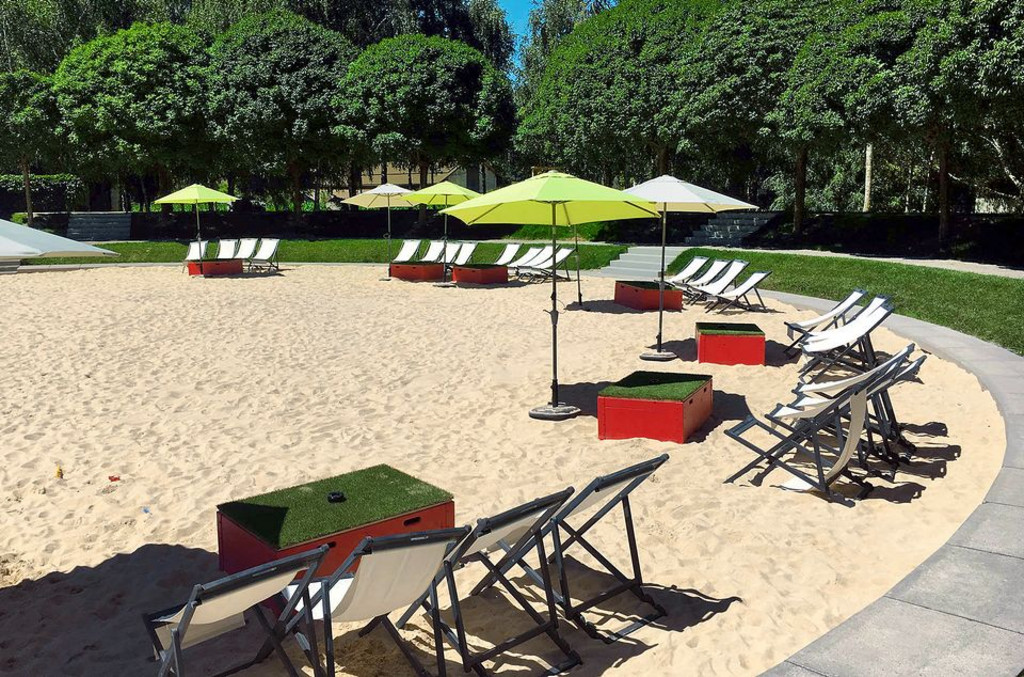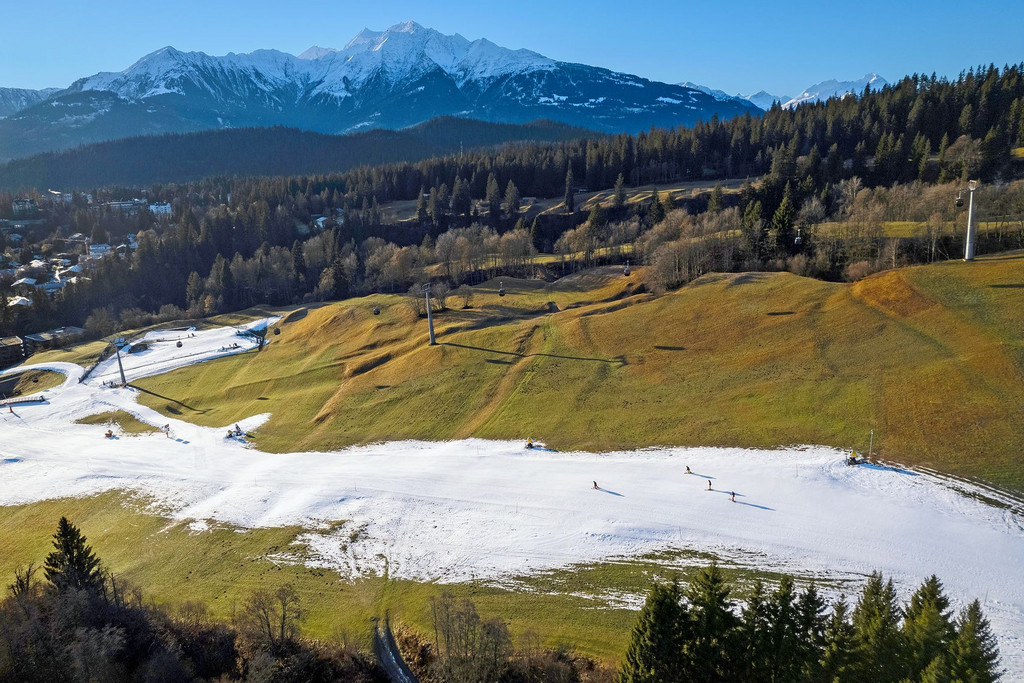
- Focus
Feeling the heat in Swiss cities
25.05.2020 – Theodora Peter
Heatwaves are becoming more common as a result of climate change. This is particularly true of cities, where summer is an increasingly sweltering affair. Vegetation, open-water areas and urban air corridors can all help to keep people cool.
On hot summer days, the water display on Berne’s Bundesplatz is popular among tourists and locals alike. In front of the imposing sandstone facades of the Federal Palace and the Swiss National Bank, children flit between the 26 fountains that symbolise Switzerland’s cantons. They then lie face down, drying themselves on the sun-baked stone. From the restaurant verandas of the old town, to the ice cream vendors lining the banks of the River Aare – the vibe is distinctly Mediterranean. In Berne and other northern hemisphere cities, this is but a taste of things to come. According to a study by ETH Zurich, which pairs the predicted climatic conditions of 520 major cities around the world in 2050 with their closest climatic likeness today, Berne will have a similar climate to that of present-day Milan in three decades’ time. London will feel like Barcelona, Stockholm like Budapest, and Madrid like Marrakech.
The latest climate scenarios reveal a likely rise in Swiss summer temperatures of between 0.9°C and 2.5°C, meaning that the number of days the mercury hits 30°C will continue to increase. Cities will bear the brunt and turn into veritable heat islands. Shadeless streets and asphalted squares heat the air like a furnace. This air is slow to cool at night, with temperatures consequently unable to dip below 20°C.
Trees – the new air conditioners
As far as Switzerland is concerned, the impact of climate change is particularly evident in Sion. No other Swiss city has recorded a sharper increase in temperature over the last 20 years. For example, the number of days with temperatures reaching at least 30°C in the capital of Valais has risen from 45 to 70 since 1984. The city launched the government-funded pilot project AcclimataSion six years ago in order to adapt urban development as well as building regulations more effectively to climate change. As city planner Lionel Tudisco puts it, the aim was “green and blue in place of grey”. This involved planting more trees in public spaces. “A tree has the same cooling effect as five air-conditioning units,” Tudisco explains. In the daytime, it can be up to seven degrees cooler where trees cast shade than in the immediate vicinity. Waterways, fountains, lakes and ditches are the ‘blue’ helping to irrigate the city. “These features create microclimates and reduce temperature fluctuations,” he says. The objective is not only to lessen the urban heat but also to mitigate the impact of floods. This is because climate change also leads to more frequent heavy rains in addition to higher temperatures – the violent thunderstorm that caused flash floods on Sion’s lower-lying roads in August 2018 being a case in point.
The landscaped Cours Roger Bonvin is the showcase feature of the AcclimataSion project. This 500-metrelong pedestrian promenade situated on the roof of a motorway tunnel used to be a rather uninviting concrete heat trap. Today, some 700 trees provide welcome shade in a public space dotted with islands of greenery. An artificial beach and generous seating and lounging areas create a holiday vibe as kids splash around in a specially constructed paddling pool.
Mapping the urban climate
Larger urban areas in Switzerland are also having to contend with climate change. Officials in Zurich want to take action – they expect a twofold increase in the average number of 30°C days from 20 to 44. “We need to stop heat from smothering the entire city,” says the head of Zurich’s environmental and health protection department, Christine Bächtiger. Specifically, this means minimising asphalt and other forms of paving, because paved surfaces are liable to heat their surroundings from all the solar radiation that they absorb. The authorities also want to relieve parts of the city that are densely populated or have a high proportion of older inhabitants who find it harder to cope in hot weather. Other options include expanding the network of paths and parks as well as enlarging less heat-prone areas of the city. Zurich has a favourable geography compared to other places, with three quarters of the city benefiting from the cool air that flows down at night-time from the wooded slopes of Zürichberg, Käferberg and Uetliberg. To preserve this natural ‘cold air system’, Zurich’s urban planners intend to keep certain air corridors free and ensure that new builds do not exceed a certain height.
The authorities in Basel have also conducted an analysis that maps the city’s ‘heat islands’, ‘green lungs’ and prevailing air flows. Spatial planners and architects used these findings to build the Erlenmatt district from scratch, positioning the buildings in such a way as to ensure that fresh air continued to blow in from the Wiesental valley. Constructed according to sustainable principles, the new neighbourhood also has a spacious park and other notable areas of greenery.
Vegetation and water
Meanwhile, the focus in Geneva is on increasing local vegetation. Last summer, officials approved a strategy that underpins the planting of greenery as part of an urban master plan, while the Urbanature project has already seen Geneva’s municipal gardeners plant around 1,200 trees and 1.7 million plants around the city. The Geneva government also believes that there has to be a fundamental shift away from the use of personal motorised transport. Residential courtyards that serve as car parks could then be transformed into green oases. Trees not only provide the city with fresh air, but their leaves also filter out particulate matter from the atmosphere.
The city of Berne is also applying a range of measures. For example, the authorities will only permit paved surfaces if these are necessary for traffic or disabled access. Rainwater begins to dry immediately when it lands on asphalt, whereas it will seep into gravel and evaporate later. “We need to rethink our approach to water,” says Christoph Schärer, director of parks and green space in Berne. Rain should no longer be drained directly into the sewers but remain where it falls, because evaporation has a cooling effect. It will also water the vegetation. “There is no benefit to covering everything in asphalt,” he says. Berne’s numerous fountains and watercourses also help to freshen the air. For example, the Stadtbach stream has been partially ‘daylighted’ along its route through the old town.
More ‘exotic’ trees are being planted in the Swiss capital. These can withstand climate change, whereas many native trees such as the large-leaved lime and the sycamore are particularly sensitive to heat and drought. The Turkey oak is one of the new tree species being used in Berne. Native to south-east Europe, this deciduous tree is resistant to cold winters and hot summers. It can also cope with the late spring frosts that have become a frequent occurrence in recent years. As far as Schärer is concerned, planting palm trees is certainly not the answer.
Adapting urban development to climate change
Extreme summer heat is harmful to public health. The mortality risk increases markedly during heatwaves. Hundreds of people in Switzerland died from the extreme temperatures in 2003 and 2015, with the elderly in urban areas particularly affected. Such heatwaves will be longer, hotter and more frequent due to climate change. The challenge for urban developers is to ensure that towns and cities continue to offer a good quality of life in a warmer climate. The Federal Office for the Environment (FOEN) drew up guidelines for adapting urban development to climate change in a 2018 report that uses examples in Switzerland and abroad to illustrate how the urban heat island effect can be reduced. However, none of this will stop the rise in summer temperatures. Excessive CO2 emissions are the root cause of climate change. A massive reduction in greenhouse gases – as prescribed in the Paris climate agreement – is the only way to counter global warming.
The FOEN report “Hitze in Städten” (in German and French)
















![[Translate to English:]](/fileadmin/_processed_/3/7/csm_max-spring-3-cartoons-de_3c29839370.png)

Comments
Comments :
Dank dem COVID19 wird endlich der eigentliche Wert des Menschen gesehen und dementsprechend Entscheidungen in Politik und Wirtschaft gefällt.
Ich weiss noch, als mein Vater, der machtlos zusehen musste, wie eine Gemeinde im Sarganserland vor etwa 50 Jahren einige biologische Flussläufe, in denen Kinder spielten und verschiedenste Frösche, Reptilien und Fische leben konnten, in Betonröhren zwangen, um schneller den Rhein zu erreichen. Als vile Einwohner sich beschwerten, gab die St.Gallische Kantonsregierung die selbstherrliche Antwort:"Wir werden der Natur trotzen!" Mein Vater war Lehrer und erklärte uns Schülern etwas wütend und traurig:"Das wird sich einmal rächen!"
Climate change is no joke or hoax. Thank you for this very informative article!
I traveled the world a lot and I can confirm British Columbia is definitely a rare Paradise on earth. I hope that a maximum of cities in the world will apply this swiss reorganisation urban model. Good job guys.